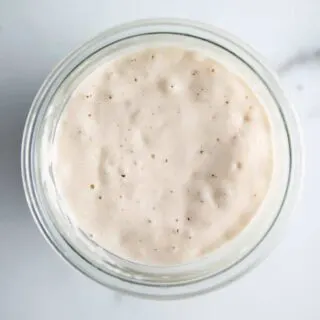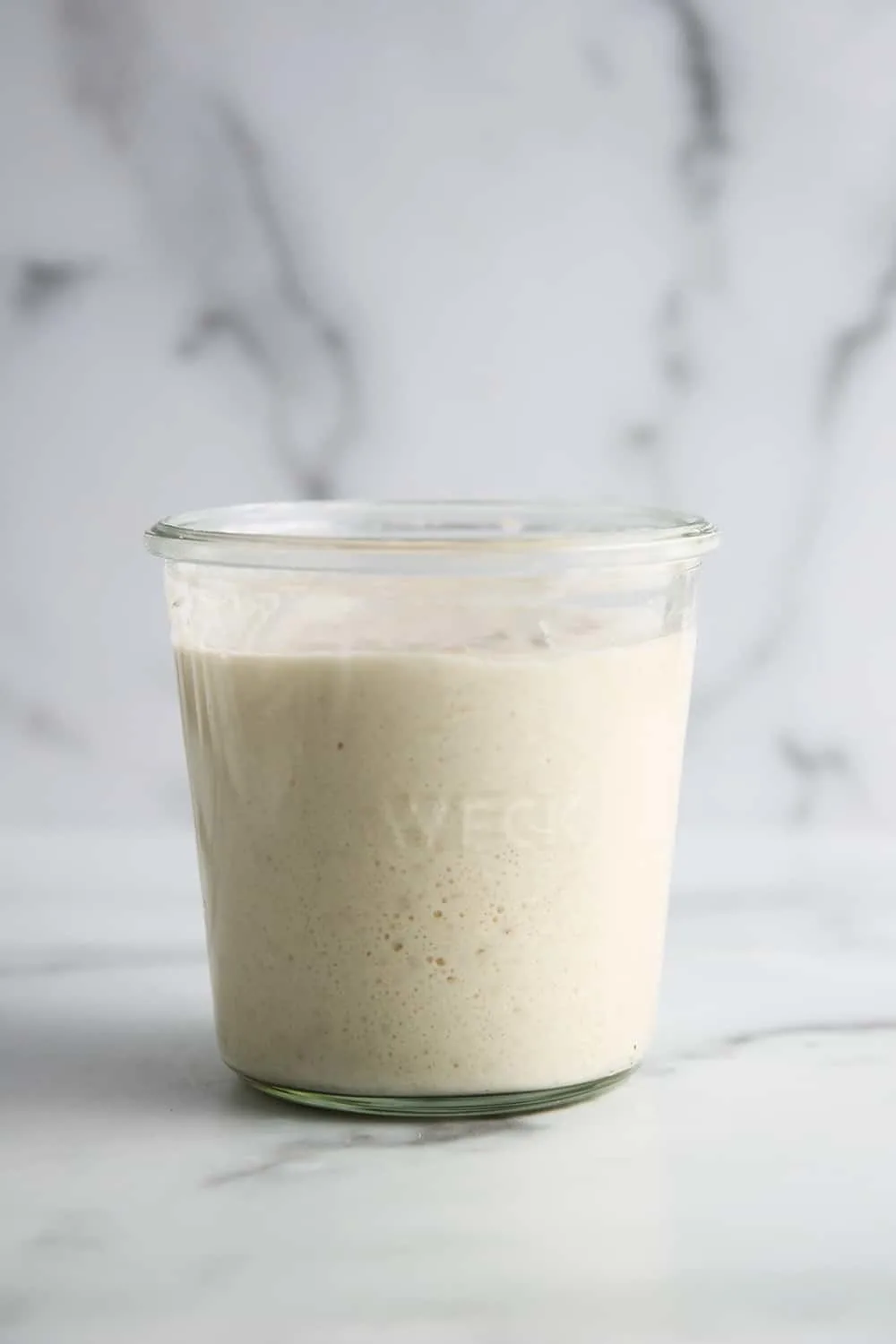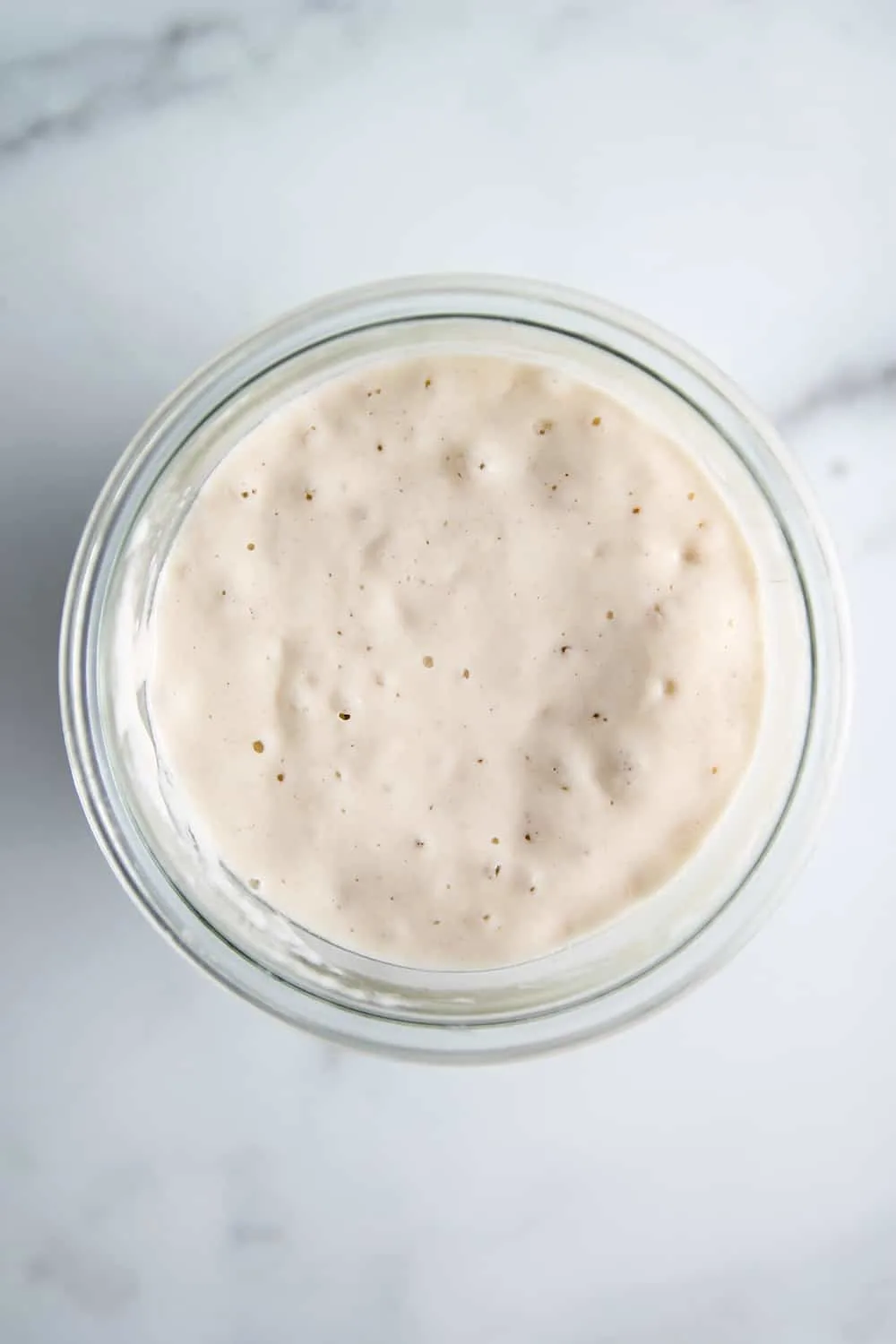Earlier this week we talked about yeast: what it is, how it works, and the differences between types of yeast. Today we are going to continue that lesson by learning about sourdough.
Sourdough is a special type of dough that differs from other yeast dough in that it contains naturally occurring yeasts (as opposed to the cultivated yeasts that we discussed earlier) in combination with a Lactobacillus culture and requires a long fermentation process.
Wait a second. We already learned that yeast is a fungus…and now we are adding bacteria to the mix? You bet!
But before you get too grossed out, remember that Lactobacillus cultures are used in the production of all kinds of other foods, including yogurt, cheese, pickles, beer, and wine, just to name a few. It is the lactic acid produced by the Lactobacilli that gives sourdough its distinctly sour taste.
In order to make sourdough bread, you must begin with a sourdough starter.
There are many types of starters, but the most basic ones are made of flour and water. The starter allows the yeast and bacteria to grow and develop, which ultimately develops the flavor of the bread and allows the dough to rise.
Because the starter is, in fact, alive, it must be taken care of and “fed” regularly with additions of flour and water. In this way, sourdough starters can be kept alive for years – there are even stories of sourdough starters being passed down from generation to generation.
Now, all of this may sound like a lot of work. Having to keep something alive and tend to it?
You might be thinking that this just isn’t for you. I once felt the same way! But really, starting and tending to a sourdough starter is not as difficult as it may seem.
To start, get a 2-quart glass jar or other container. Using the recipe below, combine your starchy potato water, flours and a bit of yeast in the jar, stirring vigorously to combine.
While natural yeasts will eventually develop, we are adding a bit of cultivated yeast to our starter just to give it a little kick-start.
Cover the jar with cheesecloth and set it in a warm place.
That is it! Once a day, give it a good stir. Smell it. Is it starting to smell slightly sour and fermented? (Read: Is it starting to smell a little like beer?) You’re on the right track!
In about 4-10 days it will start to smell nice and sour. Once it reaches this point, pour out half of the starter. You may use or throw away this starter – although, if you choose to use it, it will not have developed a very distinct sourdough flavor yet, as that takes time to develop and will get stronger with age.
Pour the other half of the starter into a clean jar and add 1 cup of white flour and just shy of 1 cup of water – you want your starter to be about the consistency of pancake batter. Cover it again with the cheesecloth and allow the starter to sit in a warm place overnight.
In the morning, place it in the refrigerator.
At least once a week, repeat the feeding process: use, discard or give away half of the starter, and add 1 cup of flour and less than 1 cup of water to the other half, leave it out overnight and return it to the fridge the next morning.
When you go to feed your starter, you may notice that a liquid has gathered at the top, ranging in color from light yellow to dark brown. This is just the alcohol produced by the yeast; simply stir this into the starter before dividing it.
However, if you notice any mold growing on the top of your starter, it means that your starter has died and you need to start over – or snag some starter from someone else. This actually happened to me once and I had to snag some of my mother’s starter.
The best way to prevent this from happening is to be diligent about feeding your starter regularly, and try not to go longer than a week between feedings.
So, what can we do with our sourdough starter? Well, for starters (see what I did there?), we can make an easy sourdough bread – and that’s exactly where we will begin on Friday! Other options include pancakes, waffles, dinner rolls, sourdough banana bread…the possibilities really are endless, and will all be explored here in due time.
So for now, get yourself a jar and get growin’!
Sourdough starter adapted very slightly from How to Bake a Perfect Life.

Easy Sourdough Starter
Ingredients
- 2 cups potato water
- 1/2 cup rye flour
- 1/2 cup whole wheat flour
- 1 cup unbleached all-purpose flour
- 2 teaspoons active dry yeast
Instructions
- In a 2-quart jar, mix all of the ingredients until smooth. Cover loosely with cheesecloth and let stand in a warm spot. Stir every 24 hours, until bubbly and agreeably sour, usually 4-10 days.
- When it is ready, store loosely covered in the fridge.
- Once a week, feed your starter: Remove from the fridge and stir vigorously, then divide starter in half. Either use, throw away or give away one half. Pour the other half into a clean 2-quart jar; add 1 cup of unbleached white flour and just enough water to make consistency similar to pancake batter (usually 1/2 to 3/4 of a cup). Re-cover with the cheesecloth and allow to sit in a warm place overnight, placing back in the fridge the next morning.



I have to start another sourdough starter…. Or you could just give me half of yours….. Just sayin. I always forget to dump it out and feed it.
You got it, girl. If I can remember, I’ll bring you some on Friday.
I have used my starter for 20 years now- When I don’t have any plans on using it for awhile, I paint my wet , well fed starter on wax paper- lined cookie sheets. When it dries I peel it off then put it in a little food chopper, grind it up and it saves in a mason jar for eternity. I prefer it ground up too for measuring. My starter is pretty strong and with it powdered, it goes easily into the dry ingredient. Just a little goes a long way!
Do you mean, Carol, that you use your dried and powdered starter as the leavening agent in quick-breads where you would otherwise use baking soda/powder? Or in place of dried yeast in yeast-bread recipes? If so, how do you adapt recipes to use your dried sourdough starter as the leavening agent? Or do you mean that you are adding it essentially just for flavoring? Thanks!
when you store it in a mason jar, does it need to be refrigerated?
Hi Pam! Yes, you’ll need to refrigerate the mature starter if you don’t want to have to feed it every day. If you keep it in the fridge, you can feed it once/week instead! Hope this helps.
I like your starter’s name. It has lots of character 🙂
I was hoping by naming it Methuselah, it will live to be as old as Methuselah was. 😉
very wise
Now I want a starter to I can give it a clever name.
I have a tendency to name my plants, too. Anything living is fair game to be named.
Awesome! I am so excited to try this! I think I’ll let my crazies name mine…which means I’ll either wind up with a “jar” or a “spongey-mcbottoms-spongepants” because in this house there is no in-between.
Hahaha, this cracked me up. Do let me know what they decide on 😉
Could you please tell me what I might be doing wrong because when I make the SD bread it doesn’t rise and have a good texture. Thank you for your help.
Hi Terri! Glad you gave the recipe a try, sorry that it hasn’t worked for yet! Let’s see…there’s a number of things that it could be, so let’s troubleshoot some common issues first:
– How old is your starter? If you just got it going, it might need a few more days (or even a week) for the yeast and cultures to develop. It will smell kind of like alcohol when it is about ready to be used.
– Your cultivated yeast might be bad. Buy a fresh package and see if that helps (be sure to check the expiration date).
– Sometimes it is hard to get yeast bread to rise this time of year, when your house might be especially cold. Try preheating your oven to the lowest setting for just a few minutes, then turning it off – you just want it warm, not very hot. You can then let your dough rise there. Alternatively, try boiling some water and placing the dough in the oven with a bowl of boiling water and allowing it to rise in that environment.
Try some of these things and see if that helps. I hope it does!
This is such a great blog!!! Really makes me hungry just reading and looking at the pictures : ) I recently baked my first loaf of bread and it was incredible!!! I used a starter my friend told me about. It’s from Sourdough’s International and now I have to spread the word! I loved it. Definitely going to order more when it comes the time.
Thank you, so glad to have you here! I am so glad you love your sourdough starter…have you named it yet? Can’t wait to hear how you explore baking with it more!
I’m always so curious as to what you’ll bring to #theWeekendSocial table. I can almost smell the sourdough baking from here. Thanks for this Starter recipe. Pinned. Can’t wait to see you’re up to this week. http://www.theKitchenChopper.com Pinned!
My starter’s name is Herman. He is my pet and so we call him “my pet Herman.” Always have. 🙂 Love that I’m not the only one that named her starter!
Love that!!
Hi there from South Africa.
Just a quick question. Do I have to use rye flour as I don’t have any. Can I just use regular wheat cake flour?
Hi Lizanne – I haven’t tried this particular starter without rye, but I have done other starters with just all-purpose flour. Seems worth a try!